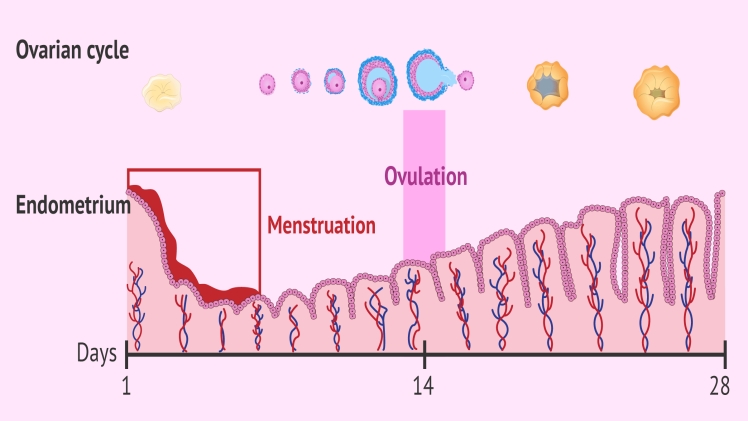Understanding your menstrual cycle and pinpointing the timing of ovulation is essential for anyone who is trying to conceive or manage their reproductive health. For individuals with a menstrual cycle lasting three days, the timing of ovulation may differ compared to those with longer cycles. In this article, we will explore the intricacies of the menstrual cycle, discuss the factors influencing ovulation, and provide insights into how to predict ovulation accurately when your period lasts only three days.
The Menstrual Cycle: A Brief Overview
The menstrual cycle is a complex interplay of hormonal events in a woman’s body, orchestrating various phases. While the typical menstrual cycle lasts about 28 days, it can vary widely from person to person, with cycles lasting anywhere from 21 to 35 days considered normal.
The menstrual cycle can be divided into several key phases:
Menstruation (Day 1-5): The cycle begins with menstruation, which marks the shedding of the uterine lining. It is often accompanied by bleeding and lasts approximately 3-7 days.
Follicular Phase (Day 1-13): Following menstruation, the body starts preparing for ovulation. The pituitary gland releases Follicle-Stimulating Hormone (FSH), which stimulates the development of follicles in the ovaries, each containing an immature egg.
Ovulation (Day 14): Ovulation is the release of a mature egg from one of the ovarian follicles. It usually occurs around day 14 in a typical 28-day cycle but can vary.
Luteal Phase (Day 15-28): After ovulation, the ruptured follicle transforms into the corpus luteum, which produces progesterone. The elevated progesterone levels prepare the uterine lining for potential implantation of a fertilized egg.
Ovulation Timing in a 3-Day Menstrual Cycle
For individuals with a shorter menstrual cycle of just three days, the window for ovulation is limited compared to those with longer cycles. Ovulation typically occurs in the middle of the cycle, regardless of its length. In a 3-day cycle, ovulation is expected around the first week of the cycle.
It’s important to remember that predicting ovulation is not solely dependent on the number of days your period lasts. Many factors, both external and internal, can influence the timing of ovulation. These include stress, lifestyle factors, hormonal imbalances, and certain medical conditions. Therefore, it is essential to pay attention to your body’s signals and use additional methods to pinpoint ovulation accurately.
Methods to Predict Ovulation
Ovulation Kits: Ovulation predictor kits (OPKs) are readily available and can be a reliable tool to predict ovulation. They work by detecting the surge in luteinizing hormone (LH) that occurs 24-48 hours before ovulation.
Basal Body Temperature (BBT) Charting: Tracking your basal body temperature every morning can help identify the temperature shift that occurs after ovulation. A rise in BBT can indicate ovulation.
Cervical Mucus Changes: The consistency and appearance of cervical mucus change throughout the menstrual cycle. It becomes clear and stretchy around the time of ovulation, resembling raw egg whites.
Calendar Method: While it may be less accurate for those with shorter cycles, keeping a record of your menstrual cycle lengths over several months can provide a general idea of when you may ovulate.
Tracking Physical Symptoms: Some women experience ovulation-related symptoms, such as mild pelvic pain or discomfort, breast tenderness, or heightened sexual desire.
Challenges of a Short Menstrual Cycle
A shorter menstrual cycle, such as a 3-day period, can present certain challenges when trying to conceive or managing reproductive health. These challenges include:
Limited Fertility Window: With a short cycle, the window for conception is narrower. Ovulation may occur within a week of the period ending, leaving less time for pregnancy attempts.
Difficulty in Predicting Ovulation: The shorter cycle can make it trickier to predict ovulation accurately using traditional methods like calendar tracking.
Potential Hormonal Imbalances: A very short cycle may be a sign of hormonal imbalances, which could affect fertility. Consulting a healthcare provider for evaluation is crucial in such cases.
Increased Stress: The pressure of timing intercourse precisely can lead to stress, which may negatively impact fertility.
Conclusion
Understanding your menstrual cycle and accurately predicting ovulation is a valuable tool for individuals trying to conceive or managing their reproductive health. While a 3-day menstrual cycle presents unique challenges, the principles of ovulation timing remain consistent. Tools like ovulation predictor kits, BBT charting, and tracking cervical mucus changes can assist in pinpointing the optimal time for conception.
It’s essential to remember that menstrual cycle length alone is not the sole determinant of fertility. If you encounter difficulties, especially if your periods are consistently very short or irregular, it is advisable to consult a healthcare provider. They can provide guidance, evaluate your reproductive health, and offer appropriate interventions or treatments as necessary. Ultimately, understanding your unique cycle and body signals is a key step toward achieving your reproductive goals.

